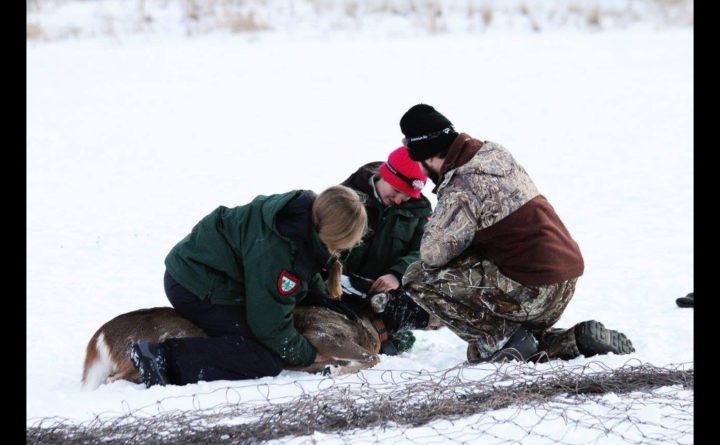
Deep in the Maine woods, crews of biologists, technicians and interns are busily “recruiting” new subjects who will help state wildlife officials better understand the role that winter severity plays on white-tailed deer mortality.
And that recruitment, which is entering its fifth year, isn’t for the faint of heart.
In order to put a GPS collar on a deer, you first have to capture that deer, according to Nathan Bieber, the state deer biologist for the Maine Department of Inland Fisheries and Wildlife.
Multiple methods have been used, including drop nets, rocket nets and an occasional tranquilizing dart. But most of the time, the capture team catches a deer in a clover trap — a metal frame with hockey-style netting — and someone (not Bieber) has to go inside and go a few rounds with the deer.
“To get the deer out of the trap you send someone in with protective gear and then they manually restrain the animal. In five minutes or less we can get a collar and ear tags on a deer, and get it out of our hands,” Bieber said.
[Subscribe to our free morning newsletter and get the latest headlines in your inbox]
Bieber said that earlier in his career, he was among those who would wrestle with the deer, using leverage to subdue the animals. Now, he has outgrown that task.
“[We have] very brave technicians and interns. I’ve done it in my past, but I’m happy to say that those years are behind me,” Bieber said. “You have to be of a certain mindset to crawl into a trap with a big, wild deer.”
The state has set up four study areas for the deer winter mortality study — one in Wildlife Management District 17 in central Maine, one in WMD 5 northeast of Baxter State Park, one in WMD 1 near Allagash and one in WMD 6 in Mars Hill.
The differing latitudes of the sites were selected to try to determine how winter severity may change the farther north in the state the deer live and to ascertain how that severity could affect the deer herd. An addition this year: Two of those sites are located near winter deer-feeding operations.
“Feeding deer is such a big part of northern Maine culture, we wanted to determine how big an impact that is having on mortality,” Bieber said. “With [Chronic Wasting Disease] being in the news again, we’re having to look at feeding options in the future for this state, and we want to know, if we do change something having to do with feeding, how is that changing the deer mortality during the winter.”
A fear is that CWD could be spread in places where deer congregate, such as at feeding stations.
Bieber said the impetus for the study was the realization that data biologists were depending on for management decisions was three decades old and could be improved upon.
“Every year when we allocate any-deer permits we account for winter severity, and the research that was supporting that up until this study was 30-year-old research when they did some dead deer surveys in deer wintering areas,” Bieber said. “Now we’ve got GPS collar technology, which is quite a bit more advanced. That research hadn’t been updated for a while, so this is an attempt to gain a better understanding, with more recent technology, of how winter severity affects winter mortality.”
Bieber said that the study groups consist mostly of adult females, although a few fawns have been fitted with collars. Bucks that are captured are fitted with ear tags and released.
GPS collars ping the deer’s location twice a day, and if the deer hasn’t moved in four hours, Bieber receives a text and an email advising researchers to check on the deer, which is presumed dead. Bieber said technicians then locate the deer and examine the remains. Still, determining the cause of a deer’s death can be difficult.
“A lot of times with a deer mortality you get to the site, and there’s very little [of the deer] left,” Bieber said.
Was a deer attacked by a predator or eaten by a carnivore after being struck by a vehicle? Or was the animal weakened by winter conditions and unable to flee? Those determinations are often made later, after closely examining all the evidence available.
[Baby moose attacks worker in Maine]
“In that case, you just take notes and pictures and somewhere down the line we’ll try to assign a most probable cause of mortality. But for now, a lot of those are just ‘unknown’ mortalities,” Bieber said. “Without being able to tell what happened to a lot of those deer, we have an incomplete picture at this point.”
Bieber said that in some cases, a femur is examined and researchers try to determine the fat content of the bone marrow. If the fat content is low, that could mean a deer was nutritionally challenged due to winter severity.
At this point, Bieber is still in the data-gathering phase of the study, which has been aided by the cooperation of the University of Maine, the University of New Brunswick, J.D. Irving Ltd., the Passamaquoddy Nation and the Quality Deer Management Association.
He looks forward to a time when the department can use the data that is being collected to formulate management decisions. To date, the data that has been gathered in the GPS study has not been utilized in management efforts.
“Every year when we allocate for [any-deer] permits, we do make adjustments based on winter severity. It’ll be nice to be able to look back on what we’ve done in the past and see if those decisions were sound. And if not, we’ll be able to adjust according to the data that we have now,” Bieber said.
This article originally appeared on www.bangordailynews.com.




